The field of knowledge hath been so traced, it is hard to spring anything new’
Though Sir Thomas Browne might be the most important thinker and writer ever to have lived in Norwich, few have read his books. Born in London in 1605, he lived in the city from 1636 until his death in 1682. A physician by profession – for which he was renowned and honoured in his lifetime – his writings cover an enviable range of topics, from spirituality and ethics to botany, natural history, mathematics, antiquity, archeology, comparative religion and occult knowledge (and these sometimes all within the same text). While his writings have the sense of piety, classical scholarship and wistful poetry that places him among other writers of his age, there’s something more about Browne’s work, a modernity sensed by those writers like Virginia Woolf, Borges and W G Sebald drawn to his thought. A habit for slipping between passing subjects along fault-lines that betray deeper and enduring structures, a playful style that weds erudition with humility, a sympathetic enquiry into other cultures and their practices, a gift for exploring a simple metaphor until it becomes a key to life, can make him feel remarkably close to us – and perhaps especially close to artists - as though one might also glimpse his recent passing on the streets around Norwich Haymarket (his home from 1650) or the ancient routes along Tombland and King Street, where he lived in his earlier years in the city.
‘Miseries are slippery’
Of Browne’s texts written in Norwich, the most famous and important are the pair of essays published together in 1658: the first and better-known, a treatise on death and memory Urne Burial or Hydriotaphia, the second and less frequently read but equally unclassifiable a meditation on the patterns of life, The Garden of Cyrus. Urne Burial starts with the excavation near Walsingham of a field of funerary urns containing human remains from the Roman settlement of Norfolk, as was then thought (in fact they were Saxon). What follows is a learned, expansive comparison of the burial and cremation practices of different cultures and periods, set as a plea on the futility of monuments, the transient span yet eternal returns of human existence, and the cycle from earth to life and back to ashes. ‘Who knows the fate of his bones, or how often he is to be buried?’ asks the essay’s preface. Readers have seized on this as prophecy, since Browne’s own skull was to be separated from the rest of his body for 82 years, and long held in a casket in the Norfolk and Norwich Hospital Museum until it was reinterred at St Peter Mancroft in 1922, a stone’s throw from Browne’s former home. No fewer than five casts of the skull were made in the interim, as if to propagate a flowering from a seemingly dead seed. From archeology comes discovery: burial must precede revelation of the wonders of time and knowledge, and – just as the life spent clinging to this soil gives little hint at the wonders of another – those things which are first hidden from sight and the mind eventually reveal themselves as truth. With Urne Burial, it is perhaps the central metaphor of the urn itself that resonates most intriguingly, that tempts us to expand. Not an ostentatious box but a humble clay pot (pledged already to the ground: earthenware, and it’s fitting that Browne’s house would later become a china warehouse) filled with mortal remains that are often accompanied by tokens and objects, that sometimes mingles the bodies of comrades or kin in a final togetherness. A container, a private reliquary of last things and memories alike, it is a sheltering space that is also a chamber, a dwelling; a vessel for a journey back to and beyond the within; the alchemist’s crucible in which opposites conjoin and change states; a sounding bell that will resonate with voices for the attentive listener. Against the melancholy loss of life, a return to that first gentle hollow, the womb. As a place of regeneration, it is also a receptacle for desires: the meaning of ‘urn’ as a ballot box has fallen from use in English but is still retained in French, where ‘to go to the urns’ means to hold an election. To reflect on the figure of the urn is also to rediscover the central, archetypal patterns of the sphere, the circle and the cycle, just as Browne’s essay takes us in receding patterns of cycles from one dust to another as the very condition of life, of fertility and growth in matter and knowledge alike; a flowerpot fertilized by memory. Inside the urn, a protective darkness that is the night’s sleep of death, just as The Garden of Cyrus ends with a hymn to the fading day and the promise of rest.
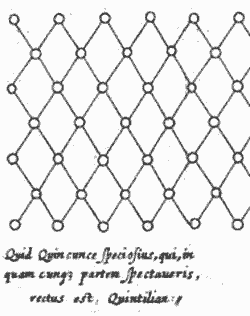
‘See, I am a burden which is lifted with five fingers’
The central figure of The Garden of Cyrus, on the other hand, is the mysterious knowledge of the quincunx – a pattern overseen by the number 5 and ‘artificially, naturally, mystically considered’ in Browne’s essay. Shown in its opening illustration as a field of lozenge or diamond shapes that are also intersections of Xs, Browne starts from the premise of the quincunx as an aesthetic principle ruling horticultural practice – like the planting of trees in offset rows – but expands this simple idea to discover the rule of 5, four points orbiting and intersecting at a central fifth point like the five spots on dice or dominos, as a sacred geometry in botany, architecture, the human frame, even vision itself. Through the mesh of the quincunx, what falls into place is nothing less than the mathematics of the world. Cited as ‘the number of justice’, regulated by the corporeal sum of the hands that produce the decimal system as 2 x 5 fingers, Browne notes how in the Roman numerals V and X – the latter made of two conjoined figure Vs – the number 5 lies embedded in the pattern of a diamond lattice. Excusing himself for dwelling on the ‘mysteries and secrets accommodable unto this number’, he notes the ancient veneration of the number 5 in Greek or Hebrew knowledge, its cabbalistic properties and magical qualities as the emblem of conjoining and ordering (the ‘wedding number’) – even if he avoids digressing on the significance of the pentagram in contemporary witchcraft, a field he was familiar enough with to have been summoned to court as an expert witness. The journey to this sacred geometry, however, begins with the problem that perhaps more than any generates Browne’s most fertile enquiries, the correspondance between the natural and the human. Ordering, tending, healing, in nearly all of his interests from the collecting and classifying activity of the naturalist to his work as a physician in which an empathy with the patient might be as significant as knowledge of human anatomy, one sees him puzzling over the moment that nature and culture meet. In this case it is the ancient discipline of horticulture, and the wonder of Persian gardens – above all the Hanging Gardens of Babylon, tended in the 6th century BC by Cyrus the Elder – that is the occasion for a discovery of the principles underlying this encounter. To picture the garden as an Edenic space of origin in this way is perhaps not so surprising: though in Browne’s time Norwich was the second largest city in England after London, it was already long noted for its profuse green spaces. As well as his private garden in Haymarket, where he would have grown medicinal plants, his notable collection of natural specimens and curiosities might make a garden of his entire home – he is said to have kept a bittern in his yard – while all around the piece of land he rented in the precincts of the cathedral for his natural history observations, now known as Browne’s Meadow, would have been fields as far as the eye could see. To sit in his library and imagine Persia is perhaps no more than a portent of the way in which even a provincial centre like Norwich acts as a place of departure and return, like the paisley-patterned shawls woven in Norwich and sent around the world by the 19th century industry that continued the city’s textile wealth from Browne’s times, their floral designs often derived from Persian motifs. Seen as a model of harmony, order and ethical rigour, in the figure of the garden East of England and Middle East cross-pollinate as Norwich dreams of Persia. For Browne, the crosswise intersections (decussations) of planting schemes run outwards to the world, in its smallest and largest structures alike. One line of flight leads to the natural universe, in the botanist’s discovery of quincunxial forms in leaves, petals, stems and trunks, and thence to spider webs, insect anatomy, reptile scales and the networks of our skin; even the human form (as already imagined by Leonardo’s Vitruvian Man) shows the X of the four cardinal points of the limbs around the central core of the body, seat of generation and growth. On the other hand Browne discerns lattice networks and intersections everywhere in significant artificial forms, from the overlapping courses of bricks and paving slabs in architectural and built environments, to webs, nets and the sprung bases of beds – woven to the measure of the sleeper.
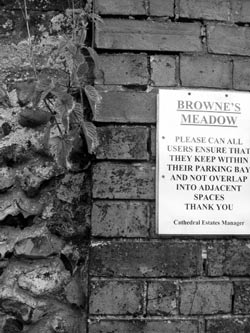
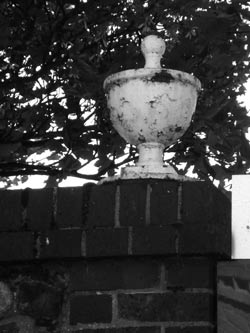
‘To weep into stones are fables’
Once alert to the rule of the quincunx we can find it everywhere as a figure for our mental and physical constructions, a paradigm of creation. Walking the streets of a city such as Norwich, tracing the X of journeys East to West from Haymarket to Browne’s Meadow as it crosses the North-South axis of Tombland and King Street, mindful that a map too is an intricate, shifting mesh, the echoes of Browne’s thought might be found at every street corner where bricks or paving square their rigorous poetry and where weeds and wildlife enliven them. In the traditional leaded lattice window, with its diamonds of glass, even light becomes a net. So, as Browne notes, is the very mechanics of perception, where the quincunx figure of an optical diagram shows light’s rays as it passes through a lens or mirror (‘answerable to the paper or wall in a dark chamber’, as he puts it). Thus the moment when the world’s facts meet the intellect, the act of perception that precedes thought, are also faithful to the rule of 5. Reflection, whether mental, visual, haptic or auditory (Browne reminds us that the senses afford us ‘five ports of knowledge’) is faithful to the beauty, symmetry and moral purity of quincunxial mathematics. For Browne, this journey from the garden is one that leads to a geometry of belief, a spiritual journey that is the ‘mystical decussation’ of body and soul, mortal and divine. How tempting it is, though, to make the suggestion that in the shapes of the quincunx and the urn, two figures can be discerned for our contemporary idea of art, that increasingly troublesome thing to define. In an age when the artwork might consist of almost anything: perhaps still a picture or an object, but equally a story, a proposition, a social engagement, an encounter or an experience, or a waeving of some or all of these things, Browne’s archetypal forms look like possible models for what artists set out to achieve. A rough or finely-wrought container that is also vessel, chamber and resonant bell; a series of speculative networks and interchanges that figure the shapes of journeys, intersections and points of contact and take us from the smallest to the greatest structures, in nature as in culture. Urne Burial and The Garden of Cyrus might contain everything required for a comprehensive definition of the job of art.
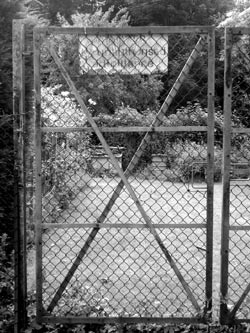
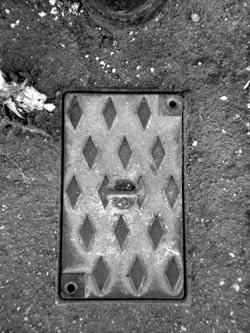
‘The ghost of a rose’
If the works of Sir Thomas Browne sit like ghosts in a library, present only to those with a particular slant of perception (like his extraordinary imaginary museum the Biblioteca Abscondita), then Browne’s physical presence in Norwich too feels dispersed and invisible. Twice commemorated in the Haymarket by monumental sculptures that probably speak more about the moment they were crafted (1905 and 2007 respectively) than the seventeenth century, the material relics of Browne’s life are harder to come by. The solid, elegant building full of collections and curiosities, with its rows of 5 windows, that was his residence for the last thirty years of his life was demolished in 1842. The charming half-timbered structure close by that was his Garden House, and in which one imagines him tending plants or observing spiders’ webs, was pulled down as recently as 1962, to make way for the rather less distinguished construction that currently houses Primark. From these houses survive two doors in Strangers’ Hall Museum (though there seems some doubt about exactly which ones they are: both are now ‘blind’ doors, opening onto walls or the backs of display cabinets), an intricate carved oak overmantel in the Bridewell Museum, and an ornate plaster ceiling rescued by the City Council and held in storage but whose trace now seems to have disappeared. On the site of Browne’s home now stands the café and terrace of Prêt à Manger, presided over by its trademark 5-point star; perhaps Browne would have welcomed its invitation to convivial encounter, its attempt, however flattened by corporate branding, at a cross-cultural perspective. But in Browne’s Meadow in the Cathedral Close, marked with a plaque but now given over to a forlorn private car park, the flora perhaps descended from plants Browne observed and catalogued resolutely push through the tarmac, as if to prove over again that the law of the cycle of rebirth from the soil, of the power of nature’s mathematics, will always triumph. Through a tall gate with its X-shaped struts, a little garden, with a vegetable plot and beehives, can be glimpsed. All along King Street –Norwich’s last remnant of the magical intersection of the very old, the very new (often imitating the very old) and the abandoned and collapsing in-between that has all but vanished from the precincts of the city centre, weeds whose names and properties he would have taught us insist on growing from the cracks in the quincunx paving.
Krzysztof Fijalkowski
Published on the occasion of the one-day performance event The Garden of Cyrus, King Street, Norwich 4th July 2009.
Further reading:
Sir Thomas Browne, Religio Medici, Hydriotaphia and the Garden of Cyrus, Clarendon Press, oxford 1972
Anthony Batty Shaw, Sir Thomas Browne of Norwich, second edition, Browne Committee of Norwich 2005
Sir Thomas Browne site, http://penelope.uchicago.edu
Melissa Gaudoin, The Green Spaces and Culture of Late Medieval Norwich, http://www.heritagecity.org/user_files/downloads/green-spaces-all.pdf, 2007